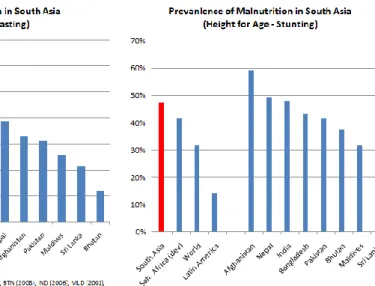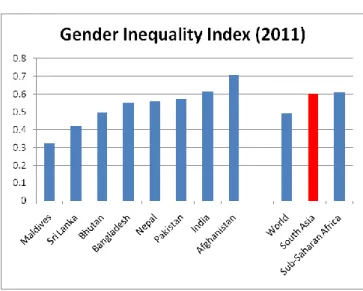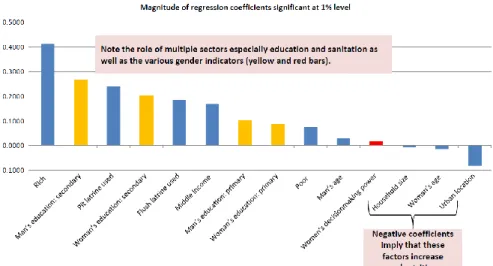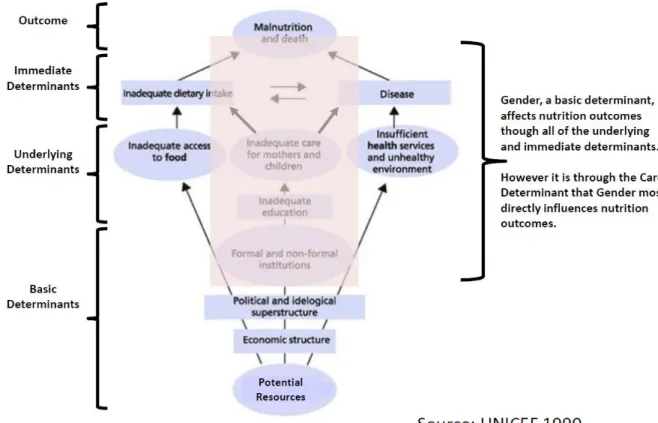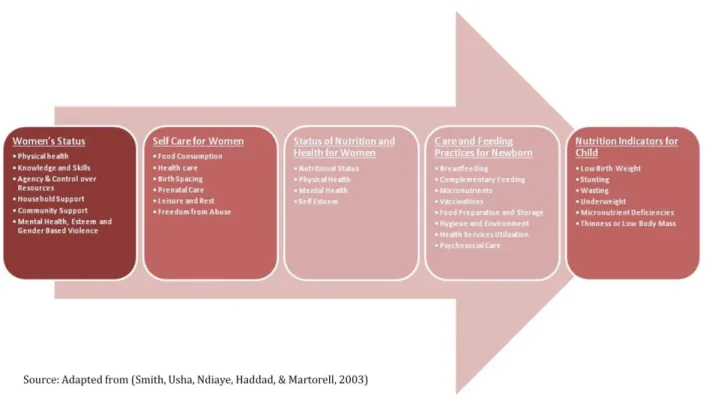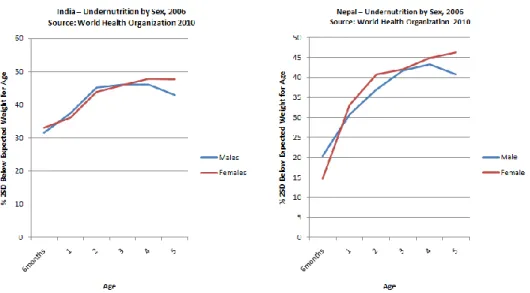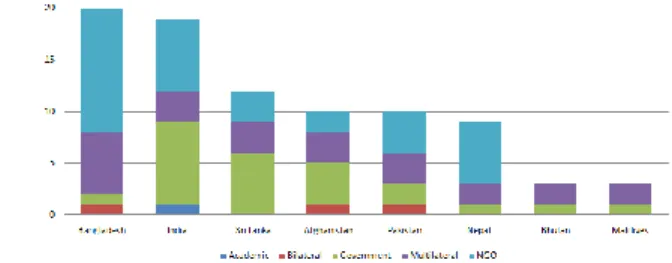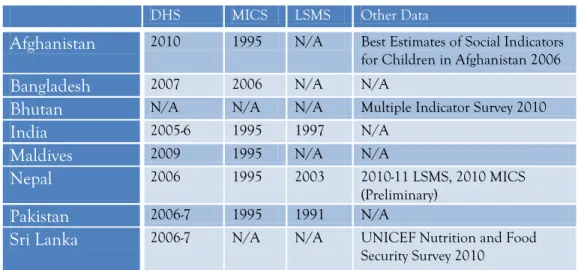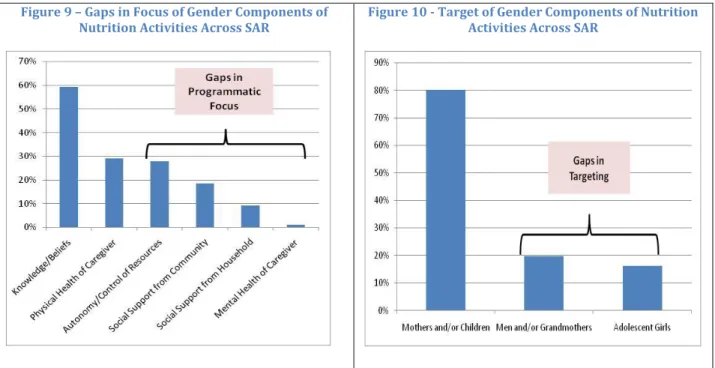Gender-Inclusive Nutrition Activities in South Asia
Mapping Report
Soham Sen & Mikael Hook
South Asia Region - Social Development Unit June 27, 2012
Public Disclosure AuthorizedPublic Disclosure AuthorizedPublic Disclosure AuthorizedPublic Disclosure Authorized
71089
This volume was created by staff of the International Bank for Reconstruction and
Development/The World Bank. The findings, interpretations, and conclusions expressed in this
paper do not necessarily reflect the views of the Executive Directors of The World Bank or the
governments they represent. The World Bank does not guarantee the accuracy of the data
included in this work. The boundaries, colors, denominations, and other information shown on
any map in this work do not imply any judgment on the part of the World Bank concerning the
legal status of any territory or the endorsement or acceptance of such boundaries. This material
has been funded by both AusAID and UKaid from the Department for International
Development; however, the views expressed do not necessarily reflect these departments’ official
policies.
3
Table of ContentsExecutive Summary ...5
Acknowledgements ...6
List of Acronyms ...6
I. Gender Matters for Undernutrition in South Asia ... 11
II. Nutrition Programs Address Gender Too Narrowly ... 17
III. Promising Interventions to More Comprehensively Address Gender ... 22
IV. The Way Forward ... 26
V. References ... 28
Appendix 1: Afghanistan Country Report ... 32
1.1 Malnutrition and Gender in Afghanistan ... 32
1.2 Mapping of Stakeholders ... 32
1.3 Government Commitment and Policies ... 34
1.4 Programs and Activities ... 34
1.5 Action Research ... 38
1.6 References ... 41
Appendix 2: Bangladesh Country Report ... 43
2.1 Malnutrition and Gender in Bangladesh... 43
2.2 Mapping of Stakeholders ... 44
2.3 Government Commitment and Policies ... 44
2.4 Programs and Activities ... 46
2.5 Action Research ... 57
2.6 References ... 63
Appendix 3: Bhutan Country Report ... 66
3.1 Malnutrition and Gender in Bhutan ... 66
3.2 Mapping of Stakeholders ... 67
3.3 Government Commitment and Policies ... 67
3.4 Programs and Activities ... 68
3.5 References ... 69
Appendix 4: India Country Report ... 71
4.1 Malnutrition and Gender in India ... 71
4.2 Mapping of Stakeholders ... 71
4.3 Government Commitment and Policies ... 72
4.4 Programs and Activities ... 73
4
4.5 Action Research ... 81
4.6 References ... 92
Appendix 5: Maldives Country Report ... 94
5.1 Malnutrition and Gender in the Maldives ... 94
5.2 Mapping of Stakeholders ... 95
5.3 Government Commitment and Policies ... 95
5.4 Programs and Activities ... 96
5.5 Action Research ... 97
5.6 References ... 99
Appendix 6: Nepal Country Report ... 100
6.1 Malnutrition and Gender in Nepal ... 100
6.2 Mapping of Stakeholders ... 101
6.3 Government Commitment and Policies ... 101
6.4 Programs and Activities ... 103
6.5 Action Research ... 107
6.6 References ... 113
Appendix 7: Pakistan Country Report ... 115
7.1 Malnutrition and Gender in Pakistan ... 115
7.2 Mapping of Stakeholders ... 115
7.3 Government Commitment and Policies ... 116
7.4 Programs and Activities ... 117
7.5 Action Research ... 122
7.6 References ... 126
Appendix 8: Sri Lanka Country Report ... 128
8.1 Malnutrition and Gender in Sri Lanka ... 128
8.2 Mapping of Stakeholders ... 129
8.3 Government Commitment and Policies ... 130
8.4 Programs and Activities ... 131
8.5 Action Research ... 134
8.6 References ... 140
Appendix 9: Additional Appendices ... 142
9.1 Policy Landscape for Gender and Nutrition ... 142
9.2 Table of Activities Identified by Mapping Exercise ... 143
9.3 List of Persons Interviewed ... 145
5
Executive SummaryThis report is the first of a series that will explore how gender can be more comprehensively incorporated into nutrition interventions in the South Asia Region in order to improve the effectiveness these programs. The first section presents the rationale for considering gender in nutrition programs in the first place, moving beyond traditional services for mothers and children. It draws from the literature to describe why gender is an important factor for the high undernutrition rates in South Asia and how a broad range of gender issues, rooted in a mother’s capacity to care for herself and her child, affect nutritional outcomes of children. The first section concludes by identifying six key issues that a gender-aware program should ideally address: the mother’s (1) knowledge and skills; (2) physical health; (3) support from other household members; (4) support from the community; (5) autonomy to make decisions and control resources; and (6) mental health.
The second section presents the results of a mapping of nutrition programs in the South Asia Region. The mapping primarily finds that, despite its importance, gender is too narrowly addressed in most interventions. Existing programs typically focus on the first two approaches mentioned above: imparting nutritional knowledge and skills to the caregiver and improving physical health through food or micronutrient supplements and health services. While knowledge and physical health are indeed essential to enhancing a mother’s capacity to provide care, the remaining four
―social‖ factors described above – household support, community support, autonomy and resource control, and mental health – which are critical to actually administering care-- are usually ignored.
Additionally, the mapping finds that programs generally do not target adolescent girls who have high rates of undernutrition and bear children at an early age.
Fortunately, these ―social‖ factors are not universally overlooked. The third section identifies several nutrition and health projects that have adopted promising approaches to include gender more comprehensively. To improve household support for the mother in providing child care, efforts to engage other members of the household such as fathers, grandmothers, and mothers-in-law appear promising. To enhance community support, interventions that leverage local groups or create mass awareness of essential nutrition actions using communications technologies such as mobile phones can be effective. To compensate for a lack of autonomy and resource constraints, programs have supported time-saving technologies as well as home gardens or other home-based economic activities under a mothers’ control. Lastly, adolescent girls have been more effectively targeted through school- based interventions and by specifically incentivizing their participation in nutrition programs. Only mental health proved to be an area not exclusively addressed by any programs identified by the mapping exercise.
The final section concludes by recommending five steps to more comprehensively address gender in
nutrition interventions: (1) Begin a dialogue with policymakers inside development institutions and
governments to expand the conversation on gender with regard to nutrition interventions that
extends beyond mothers and children. (2) Collect low hanging fruit: existing development
interventions that engage adolescent girls should include a nutrition component. (3) Facilitate the
generation of new ideas to address the programmatic gaps and improve targeting. (4) Evaluate
promising approaches for effectiveness, scalability and applicability in different cultural contexts. (5)
Conduct additional research in previously overlooked areas and fill gaps in existing data.
6
AcknowledgementsThe authors gratefully acknowledge the support of the South Asia Food and Nutrition Security Initiative (SAFANSI) for this research. SAFANSI is supported by both AusAID and UKaid from the Department for International Development; however, the views expressed do not necessarily reflect these departments’ official policies. A special thanks, also, to the many nutrition and health practitioners who were interviewed for this work. Finally, the report has benefited from the kind guidance of peer reviewers, editors and advisors inside and outside the World Bank – the authors owe them a debt of gratitude. All omissions and errors, however, are the authors’ alone.
List of Acronyms
AAMA Action Against Malnutrition through Agriculture ABCN Area Based Community Nutrition Program
ADB Asian Development Bank
AKDN Agha Khan Foundation
AKHS Aga Khan Health Services
ANDS Afghanistan’s National Development Strategy ARDS Agriculture and Rural Development Sector Strategy AWW Accredited Social Health Activist
BASICS Basic Support for Institutionalizing Child Survival
BCC Behavior Change Communication
BINP Bangladesh’s Integrated Nutrition Program
BMI Body Mass Index
BNNC Bangladesh National Nutrition Council BPHS Basic Package of Health Services
BPNI Breast Feeding Promotion Network of India BVF Baby Friendly Villages
CAF Care for Afghan Families
CCDP Child Care and Development Program CCP Center for Communications Programs CDN Child Development and Nutrition Program CENWOR Center for Women’s Research
CIDA Canadian International Development Agency CIP Country Investment Plan
CMAM Community Based Management of Acute Malnutrition
CNP Community Nutrition Program
DACAW Decentralized Action for Children and Women DFID UK Department for International Development DGFP Directorate General of Family Planning DGHS Directorate of Health Services
DHS Demographic Health Survey
EAN Equal Access Nepal
7
EC European Commission
ECCD Integrated Early Childhood Care and Development Program EKATA Empowerment, Knowledge and Transformation Action ELA Livelihoods for Adolescents
ELA Employment and Livelihoods for Adolescents Program ENA Essential Nutrition Actions
EPI National Expanded Program on Immunizations
EU European Union
FANTA 2 Food and Nutrition Technical Assistance 2 FAO Food and Agriculture Organization FHAG Family Health Action Groups
FHB Family Health Bureau
FHM Family Health Bureau
FNSP Food and Nutrition Security Policy
GAFSP Global Agriculture and Food Security Program GAIN Global Alliance for Improved Nutrition
GDP Gross Domestic Product
GESI Gender Equity and Social Inclusion GIP Girls Incentive Programme
GIP Girls Incentive Programme
HANDS Health and Nutrition Development Society HAPPI Healthy and Positive Pregnancy Initiative
HED Home Economics Department
HFP Homestead Food Production
HKI Helen Keller International
HNPSP new Health, Nutrition and Population Sector Program HNSS Health and Nutrition Sector Strategy
HPNSDP Health, Population, and Nutrition Sector Development Program IBFAN International Breast Feeding Action Network
ICDDRB International Center for Diarrheal Disease Research ICDS Integrated Child Development Services
ICRW International Center for Research on Women ICRW Center for Research on Women
IDA International Development Association IDD Iodine Deficiency Disorders
IDS Institute for Development Studies IDS Institute for Development Studies
IEC Information, Education and Communication IFPRI International Food Policy Research Institute IMCI Integrated Management of Childhood Illness INF International Nepal Fellowship
INP Integrated Nutrition Program IPHN Institute of Public Health Nutrition
8
IWEP Swayamsidha Program
IWGG Interagency Working Group on Gender IYCF Infant and Young Child Feeding JHU Johns Hopkins University
JICA Japan International Cooperation Agency JPAL Abdul Latif Jameel Poverty Action Lab
JSI John Snow Inc.
KK Kishoree Kontha
KSY Kishori Shakti Yojana
LHW Lady Health Workers Program LMRF Lata Medical Research Foundation LSMS Living Standard Measurement Survey
MAIL Ministry of Agriculture, Irrigation, and Livestock MCH Maternal and Child Health
MCH Integrated Maternal and Child Health
MCHN Improve Maternal and Child Health and Nutrition Program
MDM Mid-Day meal Program
MFDM Ministry of Food and Disaster Management MI Micronutrient Initiative
MICS Multiple Indicator Cluster Survey
MNCH Maternal, Neonatal and Child Health Care Program MNCH National Maternal, Newborn and Child Health Program
MOH Ministry of Health
MOH Ministry of Healthcare and Nutrition MOH&FW Ministry of Health and Family Welfare MOHF Ministry of Health and Family
MOHP Ministry of Health and Population MOPH Ministry of Public Health
MOWC Ministry of Women and Children Affairs MOWCA Ministry of Women and Children’s Affairs MOWCD National Rural Health Mission
MOWCSW Ministry of Women, Child and Social Welfare MSF Medicines Sans Fronteir
MTDF Mid Term Development Framework MVP Model Villages Program
MYAP Multi Year Assistance Program
NAGA Nutrition Assessment and Gap Analysis
NCCP Nutrition Coordinating Committee at Provincial Level NCU Nutrition Coordination Unit
NCWC National Commission for Women and Children NFHS 3 National Family Health Survey 3
NFP National Food Policy
NFPPA National Food Policy Plan of Action
9
NGO Non Government Organization
NHED Anganwadie Workers
NHSP II National Health Sector Programme II NNCC National Nutrition Coordination Committee
NNG Nepal Nutrition Group
NNP National Nutrition Plan NNS National Nutrition Services NNS National Nutrition Survey
NNSC National Nutrition Steering Committee NNSP National Nutrition Strategic Plan of Action NP National Nutrition Program
NPA National Plan of Action
NPAG Nutrition Program for Adolescent Girls NPAN National Plan of Action for Nutrition NRHM Ministry of Women and Child Development NRHM Nutrition, Health and Education
NRHM National Rural Health Mission NRLM National Rural Livelihood Mission
NSAPR II National Strategy for Accelerated Poverty Reduction II
NWG Nutrition Working Group
PD/HEARTH Positive Deviance/Hearth Approach PHM Public Health Midwifes
PINS Pakistan Integrated Nutrition Strategy PND Public Nutrition Department
PNDS The Pakistan Nutrition and Dietetic Society PNPS Public Nutrition Policy and Strategy PNS Public Nutrition Strategy
RACHNA Reproductive and Child Health, Nutrition and HIV/AIDS RCH Reproductive and Child Health
SABLA Rajiv Ghandi Scheme for Empowerment of Adolescent Girls SAFANSI South Asia Food and Nutrition Security Initiative
SBCC Social and Behavior Change Communication SHE Society for Health Education
SIDA Swedish International Development Agency
SOFEA Social and Financial Empowerment of Adolescents Program
SPRING Strengthening Partnerships, Results and Innovations in Nutrition Globally TIBF International Bhutan Foundation
TMSS Thengamara Mohila Sabuj Sangha TPP Tawana Pakistan Project
UN United Nations
UNFPA United Nations Population Fund
UNHCR United Nations High Commissioner for Refugees UNICEF United Nations Children’s Fund
10
UNIDO United Nations Industrial Development Organization
UNOCHA-HSU United Nations office for the Coordination of Humanitarian Affairs USAID United States Agency for International Development
WABA World Alliance for Breastfeeding Action
WFP World Food Program
WHO World Health Organization
YCSD Young Child Survival and Development Program
Gender-Inclusive Nutrition Activities in South Asia
I. Gender Matters for Undernutrition in South Asia
As compared to biological differences, (usually termed “sex”), gender refers to the “socially constructed and learned female and male roles, behaviors, and expectations” which translate biological differences between men and women into social norms that define appropriate activities, rights, resources, and power.
1The literature draws empirical links between gender and nutritional outcomes and describes several pathways through which the impact occurs including preferential treatment of male children over female, expectations of marriage and childbirth at early, adolescent ages, and a woman’s capacity to care for herself and her children during pregnancy and after childbirth. As such, a broader conversation on gender is necessary even though nutrition programs already include pregnant women and mothers.
Both gender equity indicators and undernutrition rates in South Asian countries are the worst in the world. Undernutrition rates in South Asia are roughly double those of worldwide averages and over 15% higher than the next worst region, Sub-Saharan Africa(Figure 1). Further, as shown by the Gender Inequality Index -- a composite of five variables (labor force participation, maternal mortality, adolescent fertility, educational attainment at secondary level or above, and parliamentary representation -- SAR lags behind the rest of the world in gender parity (Figure 2).
Figure 1 - Undernutrition in South Asia
1 (World Bank, 2011, p. 46).
12
Figure 2 - Gender Inequality Index (2011)2
The implications of undernutrition are dire: the condition is known to perpetuate poverty and have a significant impact on human development (Box 1 describes in greater details the
indicators used to describe undernutrition and the implications of various types). Malnourished children are more susceptible to disease and death; they have a harder time learning in school;
and, as adults, they are less productive.
3Undernourished mothers are more likely to give birth to underweight children or die in childbirth. The economic costs of undernutrition are staggering for both individuals and societies. Individuals earn 10 percent less over a lifetime and the world economy loses 2-3% of Gross Domestic Product (GDP) due to undernutrition annually.
4Box 1: What does Undernutrition Mean and How is it measured?
Undernutrition is a broad term that refers to the outcome of inadequate intake of food (calories) or essential micronutrients that the body needs to grow, resist infection and disease, learn, perform physical work, and complete other essential bodily functions.
Health and nutrition studies typically describe undernutrition in children under five years of age using the following indicators:
Stunted describes children with height measurements that are two standard deviations below the mean of the WHO Child Growth Standards median. ―Stunted‖ can be interpreted to be indicator of cumulative effects of undernutrition and infection in utero and after birth. Stunting increases the likelihood of illness and poor health, reduces cognitive development, and lowers economic productivity. Women of small stature are more likely to give birth to babies with low birth weight.
Wasted describes children with weight measurements that are two standard deviations below the WHO Standards median and. Since weight can change more quickly than height, wasting can be an indicator of both acute short-term reduction of food intake or stunting.
Underweight describes children below two standard deviations of the WHO Standards median.
This is a difficult indicator to interpret since it can reflect both wasting and stunting.
Low birth weight describes babies that are less than 2500 grams (5.5 pounds) and indicates
2 (UNDP 2011)
3 (Victoria, et al., 2008)
4 (World Bank, 2006, p. 2)
13
premature birth or restricted growth in the womb usually due to malnutrition, ill health, hard work or overall poor care of the mother during pregnancy.Undernutrition in Adults:
Underweight or Thinness describes adults who have body mass index (weight divided by height squared) less than 18.5. Mothers who are excessively thin are more likely to give birth to babies with low birth weight or suffer other complications during pregnancy and child birth.
Micronutrient deficiencies for both children and adults can refer to inadequate levels of a number of critical vitamins and minerals. The following are commonly-observed deficiencies:
Anemia describes a condition in which mothers or children below age five have hemoglobin concentrations in their blood below 110 grams/liter at sea level. Anemia indicates an iron deficiency but can also imply insufficient levels of folate, Vitamin B12 and Vitamin A. Anemia increases the risk of maternal and child mortality, reduces work capacity, and reduces physical and cognitive development.
Vitamin A deficiency refers to blood concentration of Vitamin A of less than .7 micro-mols per liter in adults and children. The deficiency causes night-blindness (blindness in low light conditions) or, in severe forms, complete blindness. It can also reduce the ability to resist infections.
Iodine deficiency refers to the condition of having an iodine concentration of 100 micrograms of iodine per liter in urine. This deficiency has significant implications for a child’s mental
development and survival.
Source: (WHO, 2010)
There is empirical evidence to suggest that gender, operating through women’s status, is an important factor driving undernutrition in the region (Figure 3). Education, for both men and women, is also critical and is widely used an indicator of women’s status.
Figure 3 - Drivers of Undernutrition in SAR
14 The theoretical determinants of malnutrition provide insight into the mechanisms through which low women’s status affects nutrition outcomes.
5As described in the diagram below (Figure 4), the immediate determinants of undernutrition are dietary intake and disease. These immediate determinants are in turn affected by underlying -- or intermediate -- determinants. For example, dietary intake is a function of (a) household food security and (b) the care that mother and child receive. The other immediate determinant, disease, is a function of again (b) the care that mother and child receive and (c) the health, environment, and other services available for care. Gender affects each link since men and women have different levels of access to resources and make different choices with regard to resource allocation.
6Access to resources and these choices are shaped by the social norms around gender that define acceptable behavior, rights, access to resources, and the power to make decisions.
Figure 4 -- Determinants of Undernutrition
This report focuses on the linkages between women’s status and nutrition operating through the care pathway since the this intermediate factor affects both dietary intake and disease, the immediate determinants of undernutrition. A mother’s low status in the household generally hampers her capacity to carry out critical infant and young child care practices such as
breastfeeding, complementary feeding, or health services utilization. As the diagram describes
5 (UNICEF, 1998, p. 24)
6There is a significant body of research that refutes the idea that households have unified preferences (the unitary model) in favor of collective models that account for differences in preferences amongst the members within a household. See for example (Alderman, Chiappori, Haddad, Hoddinott, & Kanbur, 1995).
15 (Figure 5)
7, women’s status describes: the mother’s (1) knowledge and skills; (2) physical health; (3) support from other household members; (4) support from the community; (5) autonomy to make decisions and control resources; and (6) mental health. These factors affect child nutrition through a mother’s capacity to take care of herself. This in turn also affects her health and nutritional status, which then directly affects the birth weight and nutritional status of the newborn and the quality of care the children receive.
Figure 5 –Implication of Women's Status on Care
Adolescent girls have especially low status in South Asia, and child birth by undernourished mothers in adolescence transmits undernutrition to the next generation when babies are born with low birth weight or do not receive adequate nutrition while in the womb. As the gender statistics presented above for South Asia suggest, women face a lifetime of deprivation and inequality. Indeed, the preference for male children is so significant in the region that large numbers of women are ―missing‖ due to sex selective abortions.
8Yet, such male bias not only has negative health consequences for women but also impacts their children be they boys or girls. The data show that an alarming number of South Asian children are born undernourished, and that the gap in nutritional status between male and female children begins to widen around age 4 (Figure 6). Higher quality of food and care that boys receive compared to girls in the region results in differential nutritional outcomes.
7 The framework is drawn from (Smith, Usha, Ndiaye, Haddad, & Martorell, 2003) and adapted from (Engle, Menon, & Haddad, 1999).
8 (Sen, 2001)
16
Figure 6 -- Gender Gap in Undernutrition: India and Nepal
Such differential treatment in childhood continues into adolescence for girls, leading to poor nutritional status for them and their children. Social attitudes lead women to eat last and least, and adolescent girls are often pressured to marry and give birth at an early age (Table 1). Newly- married adolescent girls experience a substantial amount of change at a time when they typically have little control over reproductive decisions or agency in dividing household chores. In addition, they often face domestic violence.
9Without sufficient status to take adequate care of themselves, they experience poor health, which in turn affects the health of their children.
10Thinness of adolescent girls can lead to complications during pregnancy and birth, higher rates of maternal mortality as well as low birth weight for babies.
11In the region, 30 percent of girls aged 15-19 are married – the highest rate in the world – and just over 20% of women have children before the age of 18. Indeed, 45% of adolescent girls in the region are thin, and 25 percent of babies are born with low birth weight, the worst rates worldwide. Such babies are more likely to die, suffer from undernutrition, and have cognitive impairments that affect their ability to learn and be productive.
Table 1-- Key Statistics on Adolescent Girls12 Adolescent
birth rate per 1,000 females aged 15 - 19 2000 - 2010
Women aged 20 – 24 who gave birth before age 18 (%)
2000 - 2010
Adolescent girls aged 15 – 19 with a BMI <18.5 (%) 2006 - 2010
Adolescents aged 15-19 currently married or in union (%) 2000 - 2010
Secondary school net enrollment ratio (%) 2007 -2010
Literacy rates (%)
2005 - 2010
Afghanistan 151 N/A N/A N/A 15 N/A
Bangladesh 133 40 35 46 43 77
Bhutan 46 N/A N/A 15 49 68
India 45 22 47 30 N/A 74
9 (Kapadia-Kundu, Khale, Upadhaye, & Chavan, 2007)
10 (Smith, Usha, Ndiaye, Haddad, & Martorell, 2003)
11 (SCN 1998)
12 (UNICEF, 2012)
17
Maldives 15 1 24 5 N/A 99
Nepal 106 23 26 32 N/A 77
Pakistan 16 10 N/A 16 29 61
Sri Lanka 23 4 N/A 9 N/A 99
As such, gendered expectations around marriage and child birth combined with the
undernutrition of female children that persists through adolescence can transmit undernutrition into the next generation of both boys and girls with consequences for their health, learning and economic status (Figure 7).
Thus, adequately addressing gender requires nutrition programs to focus not only on mothers but also on adolescent mothers. It requires programs to focus not only on health services for the mother, but also on the support she receives from the household and community, her
autonomy, and her mental health and self-esteem.
Figure 7 - Nutrition Across the Lifecycle (Ransom & Elder, 2003)
II. Nutrition Programs Address Gender Too Narrowly
The following discussion addresses several questions:
1. What are the major nutrition programs and who are their major stakeholders?
2. Do government nutrition policies reflect an awareness of the importance of gender in nutrition?
3. Do nutrition interventions typically address gender and if so, how comprehensively do they cover the spectrum of relevant issues?
4. Are important groups such as adolescent girls specially targeted?
5. Do promising approaches exist that can be scaled-up or investigated further?
18 To answer these questions, a mapping exercise was conducted of nutrition interventions and policies across the South Asia region through a process of desk research and interviews with key policy makers, program mangers, and researchers. A chain-referral sampling strategy was used to identify a network of stakeholders involved in nutrition and gender initiatives in the eight South Asian countries
13; examination of secondary sources augmented the stakeholder interviews and vice versa. These initial interviews led to the identification of other stakeholders who were subsequently contacted and interviewed. Interviews were used to gather background information on the both the gender and nutrition issues in each country, identify relevant research and programs, and map out other stakeholders to interview. Sources were identified through Google Scholar searches using key words from the gender and nutrition framework described above.
Specifically, searches included specific program information as well as general searches for
nutrition, country and combinations of other relevant keywords.
14A series of policy, program and literature summaries were produced for each country (see Country Appendices). These program summaries were then post coded according to which gender issues they addressed, what approach was used, and which groups they targeted. The national-level policy documents on nutrition were also examined for their references to gender
85 interventions with some type of gender component were identified which are currently being implemented or have recently been completed by governments, bi-laterals, multi-laterals, NGOs, or academic groups (Map 1). Often the work of the bi-lateral and multilateral organizations are in support of government programs and are not separate operations and these have not been
included. Government is the primary provider of nutrition services in India, Sri Lanka, and
Afghanistan whereas NGOs are the major players in Bangladesh and Nepal. Save the Children and CARE are amongst the most active NGOs. Amongst the international donors, UNICEF, WFP and World Bank along with USAID, a bilateral, have a significant presence in the region on the issue.
Figure 8 - Regional Distribution of Nutrition Interventions With Gender Components
13 This technique is effective in identifying hidden or unknown stakeholders, and works by identifying initial (index) individuals who subsequently recommend additional stakeholders from within their circle of acquaintances (Schensul, Schensul, & LeCompte, 1999). For this study, index stakeholders included World Bank staff with expertise in nutrition and gender, authors of notable research papers on nutrition and gender, nutrition and gender focal points at key Ministries and country offices for development partner organizations (e.g., World Bank, UNICEF, FAO, WFP, WHO, USAID, DFID, and AusAid). Initial contact was made with index stakeholders via email and phone in December 2011. Semi-structured interviews were conducted in person and over the phone from December 2011 through January 2012 using a standard questionnaire developed for this study. A total of 35 stakeholders were interviewed during this period (Appendix 3, p174).
14 These included: gender, education, access to and control over resources, autonomy, decision making and bargaining power, mothers time and childcare, mothers participation in productive work, alternative child care, paternal roles, technology that reduces time poverty, gender bias in society (i.e. different treatment, care, resources), maternal and paternal norms, values, and identities, and domestic violence.
Map 1 -- Gender and Nutrition Activities Identified in South Asia
Finding 1: With a few exceptions, the national nutrition policies of South Asian countries do not adopt broad view of gender. Nepal stands out among its South Asian peers and is currently developing an ambitious multi-sector nutrition plan that will coordinate the planning and implementation of nutrition activities across five ministries. This new plan calls for inclusiveness and gender equity, and includes strategies to empower women and improve leadership skills, address gender divisions of labor to reduce the workload on women, and improve adolescent girls’
education, life skills, and nutrition. Other South Asian countries have policies and plans in place that typically include strategies to reach pregnant and lactating women, young children, and in some cases, adolescent girls. However, few plans include specific strategies to address the
underlying gender-driven causes of undernutrition. Bangladesh and India have nutrition policies and action plans developed in the mid-nineties that are outdated, whereas Afghanistan, Bhutan, and Sri Lanka have recently updated their policies. Pakistan devolved its Ministry of Health in 2011, and provincial governments are in the process of developing their own nutrition policies and action plans to secure funding directly from development partners.
Finding 2: The lack of availability of nutrition data is also a basic constraint for some countries (Table 2). Even less data for adolescent girls exists since most nutrition surveys and studies focus on pregnant and lactating women and children up to the age of five. Recent Demographic Health Survey (DHS) data collected within the past six years is available for all South Asian countries, with the exception of Bhutan where no DHS data is available. Multiple Indicator Cluster Survey (MICS) data is available for most countries but is dated from 1995, with the exception of Bangladesh where a survey was completed in 2006 and Sri Lanka, which has no available data. A MICS for Bhutan appears to have been completed in 2010 and preliminary reports of that work are now available. Living Standard Measurement Survey (LSMS) data is only available for India, Nepal and Pakistan, and much of this data is outdated.
Table 2 - Gaps in Health and Nutrition Data
DHS MICS LSMS Other Data
Afghanistan 2010 1995 N/A Best Estimates of Social Indicators for Children in Afghanistan 2006
Bangladesh 2007 2006 N/A N/A
Bhutan N/A N/A N/A Multiple Indicator Survey 2010
India 2005-6 1995 1997 N/A
Maldives 2009 1995 N/A N/A
Nepal 2006 1995 2003 2010-11 LSMS, 2010 MICS (Preliminary)
Pakistan 2006-7 1995 1991 N/A
Sri Lanka 2006-7 N/A N/A UNICEF Nutrition and Food Security Survey 2010
Finding 3: Existing nutrition interventions do not address gender comprehensively. With regard to gender, most nutrition programs are direct interventions that directly target pregnant women, lactating mothers, and young children. These interventions employ health services, food
supplements and impart information through behavioral change communication (BCC) programs.
21 There is less emphasis on addressing other aspects of gender such as mental health, social support from the household or community, or control over resources (Figure 9).
Finding 4: Nutrition interventions rarely target adolescent girls, fathers, or elderly women, reducing their effectiveness (Figure 10). As noted above, most nutrition programs include a BCC component to teach mothers childcare and feeding practices, but BCC can be ineffective if it is not targeted with an understanding of the cultural context and gender dynamics in the household.
For example, an evaluation of the Government of Bangladesh’s Integrated Nutrition Program (BINP) by UNICEF and Save the Children in 2005 found that the BCC activities did not achieve the desired behavior change since they did not engage mothers-in-law. Although women who entered into the program improved their knowledge, a large number of women did not put this knowledge into practice. Reasons for this lack of implementation included resource constraints (women in poorer households are less likely to eat more during pregnancies and those in households owning land or that had an elderly male relative were less likely to rest during pregnancy), and the role of mothers-in-law in enforcing traditional nutrition behaviors that contradict the BCC messages (White, 2009).
Figure 9 – Gaps in Focus of Gender Components of
Nutrition Activities Across SAR Figure 10 - Target of Gender Components of Nutrition Activities Across SAR
22
III. Promising Interventions to More Comprehensively Address GenderWhile most nutrition interventions focus on gender too narrowly, several promising programs point to a way forward to address gender more comprehensively. This section notes several such programs identified during the course of the mapping exercise. Some primarily tackle a specific gender issue such as improving household support or increasing autonomy and control of
resources, while others focus on strengthening community support or on targeting adolescent girls.
Most often, however, the categorization not mutually exclusive as an intervention focused on a particular gender issue can have an impact on a number of others. Only programs addressing mental health and self-esteem and gender-based violence did not appear at all. Wherever possible, information regarding effectiveness of programs is noted. Generally, however, these interventions have been limited in implementation and scale, and efforts to evaluate their effectiveness have been inconsistent.
Household Support
Efforts to improve household support for the mother often incorporate husbands and elderly women in the household such as mothers-in-law or grandmothers. As noted earlier, instruction in care and feeding practices is typically delivered by female community health workers through behavioral change communications (BCC) programs focused on the pregnant woman or mother.
BCC programs may see better results by combining broader targeting and adult learning approaches instead of passively presenting information to women. For instance, Save the Children’s Child Survival 19 Project in Northwestern Afghanistan has implemented a Positive Deviance approach
15to promote household behaviors among mothers, mothers-in-law and
caregivers that can lead to good nutrition outcomes. A mid-term evaluation of the program found that 90% of children enrolled in the program demonstrated significant weight gain. The
evaluation team concluded that the Positive Deviance/Hearth model was effective at changing household behaviors, and could generate nutritional improvements for infants and small children in Afghanistan (Save the Children, 2006). Another Save the Children’s program, Saving New Born Lives Initiative in Pakistan, also implemented Positive Deviance trainings to change behaviors in the community and households that included mothers, mothers-in-law, fathers, fathers-in-law, and unmarried men and women. Results data showed that there was a 45% decrease in the number of mothers who gave pre-lacteal feeds to the newborns within 3 days of birth.
Another promising approach might be to vary the individual responsible for delivering the information. For example, in addition to female health workers, in India, Concern Worldwide is piloting the Male Health Workers for Accessible Health Care project. The project aims to provide maternal health and nutrition information to husbands using a group of male community health workers. Currently, men make a number of decisions regarding food purchases and health
15 Positive deviance approaches identify high performers from the community and facilitate peer to peer learning to spread good practices from these high performing “deviants” to others to improve their outcomes.
23 care access which affect nutritional outcomes. However, they often lack any training on maternal health or nutrition. The typical health volunteer is usually female and faces difficulties reaching out to men to discuss family planning or nutrition issues. Male health workers, acting as peer counselors, may have greater success. A pair of male and female health workers working together could also travel more safely at night and to more isolated places, extending the reach of their services overall (Concern Worldwide, 2012).
Similarly, the Grandmother Project, through their work on several projects mostly in Africa, recognizes the role grandmothers play in maternal health and childcare by transmitting
information between generations, influencing men and younger women in the household, and providing guidance on pregnancy and child-rearing. The Project has designed programs to leverage the special role of grandmothers to act as nutrition educators and sources of influence to change behaviors and adopt new practices. In one instance, Indian daughters-in-law were found to learn better and adopt new practices more quickly when being taught by grandmothers or mothers-in-law (Aubel, 2010).
Community Support
Moving beyond framing community support for nutrition as involving only growth monitoring and promotion, a number of projects are trying to form community groups or create mass awareness campaigns using various communications approaches and technologies. For example, the Shouhardo project implemented by CARE in Bangladesh used a rights-based livelihoods approach and implemented a range of activities focused on mother and child health and nutrition, sanitation, women empowerment, poverty and food insecurity alleviation, empowerment of the poor and disaster mitigation and response. The women’s empowerment component was
comprised of three interventions: support for the formation of social groups for women and adolescent girls, pre-school for young girls, and formation of parent-teacher associations. An impact evaluation of the Shouhardo project by the Institute for Development Studies (IDS) found that stunting prevalence among project participants fell by nearly 16 percentage points over a three-and-a-half year period. The evaluation also found that the project’s women’s empowerment interventions had the strongest independent impact on stunting (Smith, Khan, Frankenberger, &
Wadud, 2011). CARE is currently implementation a follow
-on Shouhardo II program, and Save the Children is implementing a smaller scale program with similar objectives called Nobo Jibon.
Similarly, The Government of Pakistan implemented the Tawana Pakistan Project (TPP), a pilot
project from 2002 to 2005 to address poor nutrition status and school enrolment of primary
school-age girls. TPP’s main intervention involved creating a safe environment for village women
to make collective decisions. Women were taught to plan balanced menus, purchase food, and
prepare and serve a noon meal at school prepared using locally available foods at nominal costs
(USD 0.12/child). An evaluation of the project found that wasting among participating girls
decreased by 45% (from 14.3% to 7.9%). The number of underweight girls decreased from 23.2 %
to 18%. Chronic under-nutrition and stunting only decreased by 6% during the duration of the
project. The project increased school enrollment by 40% by attracting un-enrolled girls who came
24 to attend the feeding program. The average number of girls per school also increased from 64 to 89 by the end of the project (Badruddin, Agha, Peermohamed, Rafique, Khan, & Pappas, 2007).
The groups can include more than just women. In Afghanistan, Care for Afghan Families (CAF) implements the Baby Friendly Villages program in four districts of Takhar Province. The
program seeks to improve child-feeding practices by creating breastfeeding support groups with all key stakeholders– including mothers-in-law, husbands and other male members of the family, health workers, traditional healers, birth attendants, and local religious leaders. The project combined such groups with breastfeeding counseling centers and enlisted the support of community health workers and professionals health services. The objective focused on transforming entire villages into baby-friendly locations where all individuals have the proper knowledge and skills to support a breastfeeding mother.
Mass media campaigns can spread awareness about undernutrition identification and
prevention practices using a variety of methods and technologies. Save the Children’s Integrated Nutrition Program (or Suaahara) in Nepal combines a communications program, mass media campaigns, and a community mobilization strategy that uses music, theater, links to religious festivals. Concern Worldwide is implementing the Local Government Partnership to Combat Child Undernutrition project in Bangladesh which engages men through awareness campaigns using a combination of traditional tools and modern technologies such as cell phone messages, awards and subsidized services to promote behavior change. The program also encourages support from local government and women’s participation in leadership bodies. Equal Access Nepal (EAN) is implementing the Nutrition through Knowledge project in Nepal. The project uses radio programs to raise awareness among parents about infant and young child nutrition to empower women to address various socio-cultural determinants of undernutrition at the household level, and to engage men as key stakeholders, agents of change, and advocates within families.
Autonomy, Decision-Making and Control Over Assets
Nutrition programs can do much to ease constraints of resource access and autonomy. However, increasing women’s autonomy, decision-making and control over assets cannot be the work of nutrition programs alone. The contributions of programs focused on education, livelihoods, financial inclusion sectors are vital.
For instance, Helen Keller International (HKI) is implementing a Homestead Food Production (HFP) program in Bangladesh and Nepal, which integrates nutrition, agriculture and food production, maternal self-care, infant and young child feeding, gender awareness, and women’s empowerment interventions. An evaluation of the HFP model in Bangladesh, Cambodia, Nepal and the Philippines from 2003 to 2007 showed that HFP participants increased production and consumption of vegetables and animal food products, increased household earnings that were used to purchase additional foods, and reduced the incidence of anemia among mothers and children compared to the control group. The evaluation found that the HFP program empowered women, giving them more control over household resources from the income generated from their
homestead food production activities. Such control over HFP resources and income is likely a key
25 factor in how the program has enhanced women’s participation in household decision-making.
The study also found that homestead food production has a potential positive impact on overall household spending, food preparation, food choices and intra-household food allocation as well as care-seeking behavior of women (HKI, 2010).
Another project uses technology to ease mobility constraints. In India, Lata Medical Research Foundation is implementing an innovative project that seeks to use cell phone technology to improve breastfeeding and reduce infant mortality. The project seeks to empower women to overcome barriers of leaving their home after delivery due to limited transportation by providing mothers with information, guidance and coaching through mobile phones.
Targeting of Young and Adolescent Girls
Schools offer the most promising means to target younger girls. The WFP’s Girls Incentive Programme (GIP) in Nepal provides schoolgirls with monthly rations of oil to take home as incentive for regular school attendance. Keeping girls in schools is critical for enhancing agency later in adolescence, and delaying marriage and childbirth. WFP implements the program as part of its broader school feeding program in 11 Western districts and independently in five Terai districts where girls’ school attendance has been found to be particularly low. The WFP has reached more than 62,000 school girls through this program, and rates of girls’ school attendance have increased by as much as 27% in areas where WFP has implemented GIP (WFP, 2012).
Similarly, the WFP School Feeding Program in Bangladesh provides a daily micronutrient fortified biscuit to primary school students in participating schools that serve as an incentive for families to keep their children in school. A midterm evaluation of the program found that
attendance rates increased between baseline and follow-up in all months for both boys and girls in the treatment schools. These differences were highly significant (p<0.001). The evaluation also found that increases in attendance were consistently slightly higher for girls than boys, although these differences were not statistically significant (Rogers, Coates, & Osei, 2004).
While adolescent girls are much more difficult to reach, one approach is to provide services and information relevant to adolescents and incentivize their participation. In India, the
government has launched a adolescent girls program termed SABLA
16, which will be piloted in 200 districts all across the country and aim to reach adolescent girls, aged 11-18, with nutrition and job training interventions to be delivered in conjunction with the Integrated Child
Development Scheme at local health centers (anganwadi centers) by community health workers.
The program focuses on those who have dropped out of school as well as those who have dropped out. Through the bi-montly meetings, girls will receive a food supplement, micronutrient
supplements, health checkups, family planning and reproductive counseling, life skills education and guidance on accessing government programs, and vocational training for those above the age of 16 (ICDS, 2009).
Similarly, the Kishoree Kontha (KK) project in Bangladesh run by Save the Children with support from the Nike Foundation. The KK program aimed to link savings schemes with other
16 Full name is The Rajiv Gandhi Scheme for Empowerment of Adolescent Girls.
26 non-financial services, such as health and education, to allow rural adolescent girls aged 10-19 to build human, social and economic assets. Using a group mechanism, girls were empowered to make their own decisions in terms of savings and were then given access to credit to transition to income-generation activity. The Abdul Latif Jameel Poverty Action Lab (JPAL) is conducting a randomized control trial to evaluate the effectiveness of the KK project, and Save the Children is moving forward with the UK Department for International Development (DFID) to implement a larger scale project using the KK model based on preliminary successes (IPA, 2011).
IV. The Way Forward
The preceding sections have discussed the linkages between gender and nutrition outcomes in South Asia and presented evidence from a mapping exercise to suggest that policy makers conceive of gender too narrowly and nutrition interventions addressed inadequately address gender-based factors. Gaps were noted in the programmatic focus of existing programs; programs heavily emphasize providing information and health services and fail to adequately mobilize household and community support or increase a mother’s agency and autonomy. Gaps were also noted in targeting. Most existing nutrition services target mothers and young children and neglect the needs of adolescent girls and the important roles of men, mothers-in-law, and grandmothers. Even basic nutrition data is unavailable in some countries. Various approaches to close these gaps that have been taken by implementing organizations in the region were discussed.
Five areas of follow-up to this discussion constitute one way forward:
(1) Begin a dialogue with policymakers inside development institutions and governments to expand the conversation on gender and nutrition that goes beyond a narrow focus on mothers and children. This dialogue should include:
a focus on adolescent girls;
increased support for mothers and children from the household and community;
interventions to reduce resource constraints to providing proper nutritional care for a mother and her child, and;
efforts to improve mental health and self-esteem of caregivers.
(2) Collect low-hanging fruit. Existing development interventions that engage adolescent girls
should include a nutrition component. In particular, development partners should expand
school-based nutrition programs that provide incentives to families for keeping their girls in
school. Generally, policy makers should be encouraged adopt multi-sectoral nutrition policies with
gender-inclusive strategies. When governments and development partners begin to view the
nutrition problem in a more holistic way that addresses multiple sectors, gender-driven causes of
nutrition concerns become more visible as they are themselves cross cutting issues. In this respect,
multi-sectoral policies create an enabling environment for developing gender-inclusive nutrition
approaches. Ministries in charge of women and children’s affairs should be engaged, in addition to
the ministries of health and agriculture, in the development of gender-inclusive, multi-sector
policies to tackle nutrition.
27 (3) Support and facilitate the generation of new ideas to address the programmatic gaps and improve targeting. Consultations with experienced practitioners, policy makers, community health workers, as wells as beneficiaries may generate new ideas. Grant competitions to identify or scale new approaches may also be beneficial.
(4) Evaluate promising approaches for effectiveness. A lack of evidence on the effectiveness of interventions hampers their widespread adoption by governments and development partners. Pilot studies should test, for example, whether nutrition outcomes can be improved by:
targeting BCC to other household members such as men, grandmothers and/or mothers- in-laws
distributing behavioral change messages through male community health workers or elderly women in the household
the use of various types of social groups to generate community support
generating mass awareness using various mechanisms such as ICTs, television, radio, arts, media personalities
introducing a range of time saving technologies
providing additional homestead production activities and livelihood activities (5) Conduct additional research in gap areas and fill holes in existing data, including the following:
Knowledge, attitudes and practices of men and elder women in the household related to the care of women and children. An understanding of family systems and cultural systems is also necessary.
Targeting adolescent girls requires region-specific information on the lives of adolescent girls and the mapping of institutions that might be used to reach them. Stakeholders interviewed noted that there is little knowledge on the roles and expectations of adolescent girls in households between the ages of five and pregnancy and how this influences
nutrition outcomes.
Health and Nutrition Data should be disaggregated for adolescent girls across the region.
General health and nutrition information availability is poor in Bhutan.
Given the lack of programs on mental health and self-esteem and on the incidence of gender-based violence experienced by caregivers, region-specific research should draw out the linkages between mental health, care practices and ultimately nutrition outcomes.
Possible interventions should be identified.
28
V. ReferencesAlderman, H., Chiappori, P.-A., Haddad, L., Hoddinott, J., & Kanbur, R. (1995). Unitary versus collective models of the household: is it time to shift the burden of proof? World Bank Research Observer , 1-19.
Ashrafi, H. (2009). Gender dimension of agriculture and rural development: special focus on Afghan rural women's access to ariculture and rural development sector. FAO. FAO.
Aubel, J. (2012). The role and influence of grandmothers on child nutrition: culturally designated advisors and caregivers. Maternal & Child Nutrition , 19-35.
Aubel, J. (2010). The roles and influence of grandmothers and men. Washington, DC: USAID.
Aubel, J., Touré, I., Diagne, M., Lazin, K., Sène, E. H., Faye, Y., et al. (2001). Strengthening Grandmother Networks to Improve Community Nutrition: Experience from Senegal . Gender and Development , 62-73.
Badruddin, S. H., Agha, A., Peermohamed, H., Rafique, G., Khan, K., & Pappas, G. (2007). Tawana project-school nutrition program in Pakistan: its success, bottlenecks and lessons learned. The Aga Khan University.
Bhagowalia, P., Menon, P. Q., & Soundararajan, V. (2010). Unpacking the Links Between Women's Empowerment and Child Nutrition: Evidence Using Nationally Representative Data From Bangladesh.
Selected Paper prepared for presentation at the Agricultural & Applied Economics Association 2010 AAEA,CAES,
& WAEA Joint Annual Meeting, Denver, Colorado, July 25-27, 2010. Denver.
Bhattacharjee, A., & Das, N. C. (2011). Profile of Adolescent Girls: Findings from the Baseline Survey for Social and Financial Empowerment of Adolescents (SoFEA) Programme. BRAC. BRAC.
Concern Worldwide. (2012). Male Health Workers for Accessible Health Care. Retrieved May 15, 2012, from Innovations for maternal, newborn, and child health: http://innovationsformnch.org/finding-what- works/male-health-workers-for-accessible-health-care
De Silva, D. (2011, December 28). Nutrition Specialist, WFP/Sri Lanka. (M. Hook, Interviewer)
DiDio, D., Schumacher, B., & Choudhury, N. (2011, December 11). Gender and M&E Consultant and Nutrition and Food Security Specialists, WFP Bangladesh & Nutrition Colleagues. (M. Hook, Interviewer)
Engle, P., Menon, P., & Haddad, L. (1999). Care and Nutrition: Concepts and Measurement. World Development , 27 (8), pp. 1309-1337.
Garret, J., & Natalicchio, M. (. (2011). Working Multisectorally in Nutrition. Washington, DC: IFPRI.
Grace, J. (2004). Gender roles in agriculture: case studies in five villages in Northern Afghanistan. Afghanistan Research and Evaluation Unit. AREU.
HKI. (2010). Homestead Food Production Model Contributes to Improved Household food Security, Nutrition and Female Empowerment: Experience From Scaling-Up Programs in Asia. HKI. HKI, Nutrition Bulletin.
ICDS. (2009). Sabla Scheme. Retrieved 10 2012, June, from Integrated Child Development Service:
http://www.cdpo.ewebsite.com/articles/sabla-scheme.html
IPA. (2011). Empowering Girls in Rural Bangladesh. Retrieved Jan 2012, from Innovations for Povery Action:
http://poverty-action.org/project/0121
